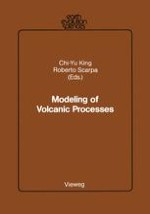
1988 | OriginalPaper | Chapter
Seismological Detection and Delineation of Magma Chambers Beneath Intraplate Volcanic Centers in Western U.S.A.
Author : H. M. Iyer
Published in: Modeling of Volcanic Processes
Publisher: Vieweg+Teubner Verlag
Included in: Professional Book Archive
Activate our intelligent search to find suitable subject content or patents.
Select sections of text to find matching patents with Artificial Intelligence. powered by
Select sections of text to find additional relevant content using AI-assisted search. powered by
In this review I describe results from experiments conducted by the U.S. Geological Survey in diverse volcanic environments to image velocity anomalies in the crust and upper mantle using teleseismic P-wave residuals. The linear least-squares inversion technique of Aki et al. (1976, 1977) is extensively used in these studies. The seismic models thus obtained are synthesized with available geologic and geophysical data to infer plausible models of magma genesis in these regions. The three-dimensional velocity model beneath Yellowstone Plateau shows a large low-velocity body of approximately 100 km diameter centered on the caldera and extending from the crust to a depth of about 250 km. This is interpreted to be a massive magma body which is responsible for the volcanism during the past 2 m. y. in Yellowstone. Teleseismic S-wave residuals, Raleigh-wave dispersion data, heat-flow, gravity, Curie isotherm depths, and magnetotelluric data, all support the existence of a temperature near granite solidus beginning at a depth of 5-10 km beneath the Yellowstone caldera floor. In the Eastern Snake River Plain (ESRP) a low-velocity anomaly is present in the upper mantle but not in the crust, leading to the speculation that ESRP is the healed track of a northeast propagating volcanic center whose present position is Yellowstone. The seismic model for the ESRP-Yellowstone volcanic system, though unable to distinguish between different models of origin of the system, clearly shows that basaltic magma rises from the mantle, melts the lithosphere and yields massive quantities of rhyolitic magma.The seismic velocity structure beneath Hawaii, an oceanic hot spot, shows a complex crustal structure with no evidence for a large magma chamber in the crust. However, in the upper mantle there is an elongate north-south trending low-velocity zone, 200 km wide and traceable to a depth of 165 km. Thus, similar hot-spot generation models in the asthenosphere may be applicable to Yellowstone and Hawaii, though the chemistry and volume of surface volcanism is greatly different in the two areas.In all the six intra-plate silicic volcanic centers which we have probed using the teleseismic-residual technique, low-velocity anomalies, inferred as crustal magma chambers have been found. In at least one such volcanic center, Long Valley in California, uplift and S-wave attenuation measurements support that the magma chamber delineated by tele-seismic residuals is real. The suggestion of a root to the magma chamber extending into the upper mantle supports the geologic model for magma genesis in these centers, namely, infusion of basaltic magma from the asthenosphere into the lithosphere and crust, and resulting partial melting. In contrast to the silicic volcanic centers, none of the andesitic Cascade volcanoes show evidence for crustal magma chambers detectable using the teleseismic technique. Teleseismic-residual data in two volcanoes, Newberry in Oregon, and Medicine Lake in California, show massive high-velocity intrusions in the crust beneath the volcano edifice. A high-resolution seismic imaging experiment has revealed the presence of a low-velocity anomaly which could be a dike-like molten magma pocket within the high-velocity intrusive in Newberry volcano. On a regional scale, the teleseismic residual experiments using long profiles have successfully delineated high-velocity anomalies, possibly related to subduction, in the Oregon Cascades, and a low-velocity anomaly due to asthenospheric upwarp beneath the Rio Grande Rift.